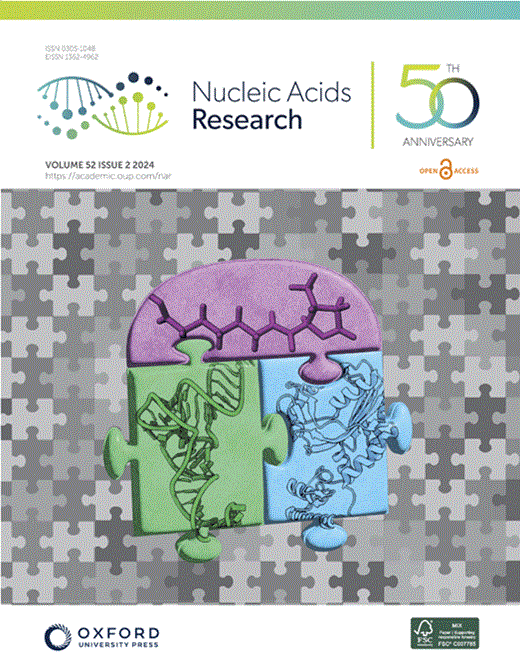用于揭示基因功能和调控网络的 PerturbDB
IF 16.6
2区 生物学
Q1 BIOCHEMISTRY & MOLECULAR BIOLOGY
引用次数: 0
摘要
Perturb-Seq结合了基于CRISPR(聚类规则间隔短回文重复序列)的遗传筛选和单细胞RNA测序读数,用于高含量表型筛选。尽管 Perturb-Seq 数据集积累迅速,但仍然缺乏一个用户友好型平台来实现数据集的有效再利用。在此,我们开发了 PerturbDB (http://research.gzsys.org.cn/perturbdb),一个帮助用户利用 Perturb-Seq 数据集揭示基因功能的平台。PerturbDB 承载了 66 个 Perturb-Seq 数据集,其中包括 4 518 521 个单细胞转录组,这些转录组来自 19 种不同细胞系的 10 194 个基因的敲除。所有数据集均使用 Mixscape 算法统一处理。根据 Perturb-Seq 数据得出的扰动转录组表型对基因进行聚类,得出 421 个基因簇,其中 157 个基因簇在不同的细胞环境中保持稳定。通过整合化学扰动转录组与 Perturb-Seq 数据,我们发现了针对 1409 个基因的 552 种潜在抑制剂,其中包括一种经实验验证的哺乳动物雷帕霉素靶标(mTOR)信号抑制剂--视黄醇。此外,我们还开发了一个 "癌症 "模块,以便于利用 Perturb-Seq 数据了解基因在癌症中的调控作用。我们还开发了一个交互式网络界面,使用户能够可视化、分析和下载 PerturbDB 中的所有综合数据集。PerturbDB 将极大地推动基因功能研究,加深我们对基因在癌症等疾病中调控作用的理解。本文章由计算机程序翻译,如有差异,请以英文原文为准。
PerturbDB for unraveling gene functions and regulatory networks
Perturb-Seq combines CRISPR (clustered regularly interspaced short palindromic repeats)-based genetic screens with single-cell RNA sequencing readouts for high-content phenotypic screens. Despite the rapid accumulation of Perturb-Seq datasets, there remains a lack of a user-friendly platform for their efficient reuse. Here, we developed PerturbDB (http://research.gzsys.org.cn/perturbdb), a platform to help users unveil gene functions using Perturb-Seq datasets. PerturbDB hosts 66 Perturb-Seq datasets, which encompass 4 518 521 single-cell transcriptomes derived from the knockdown of 10 194 genes across 19 different cell lines. All datasets were uniformly processed using the Mixscape algorithm. Genes were clustered by their perturbed transcriptomic phenotypes derived from Perturb-Seq data, resulting in 421 gene clusters, 157 of which were stable across different cellular contexts. Through integrating chemically perturbed transcriptomes with Perturb-Seq data, we identified 552 potential inhibitors targeting 1409 genes, including an mammalian target of rapamycin (mTOR) signaling inhibitor, retinol, which was experimentally verified. Moreover, we developed a ‘Cancer’ module to facilitate the understanding of the regulatory role of genes in cancer using Perturb-Seq data. An interactive web interface has also been developed, enabling users to visualize, analyze and download all the comprehensive datasets available in PerturbDB. PerturbDB will greatly drive gene functional studies and enhance our understanding of the regulatory roles of genes in diseases such as cancer.
求助全文
通过发布文献求助,成功后即可免费获取论文全文。
去求助
来源期刊

Nucleic Acids Research
生物-生化与分子生物学
CiteScore
27.10
自引率
4.70%
发文量
1057
审稿时长
2 months
期刊介绍:
Nucleic Acids Research (NAR) is a scientific journal that publishes research on various aspects of nucleic acids and proteins involved in nucleic acid metabolism and interactions. It covers areas such as chemistry and synthetic biology, computational biology, gene regulation, chromatin and epigenetics, genome integrity, repair and replication, genomics, molecular biology, nucleic acid enzymes, RNA, and structural biology. The journal also includes a Survey and Summary section for brief reviews. Additionally, each year, the first issue is dedicated to biological databases, and an issue in July focuses on web-based software resources for the biological community. Nucleic Acids Research is indexed by several services including Abstracts on Hygiene and Communicable Diseases, Animal Breeding Abstracts, Agricultural Engineering Abstracts, Agbiotech News and Information, BIOSIS Previews, CAB Abstracts, and EMBASE.
 求助内容:
求助内容: 应助结果提醒方式:
应助结果提醒方式:


